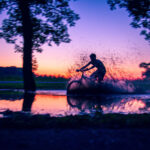What ultimately shapes a portrait? Does it have more to do with the subject—who they are, how comfortable they are in front of the camera, etc.—or does the photographer possess most of that power, able to mold an image according his or her knowledge of the subject and how skilled he or she is with a camera?
Canon wanted to find out, so they developed Decoy, one of six experiments aimed at “shifting creative thinking” among photographers. Watch what happens in their portrait session with a twist:
To conduct the “Decoy” experiment, Canon recruited six portrait photographers and asked them to create portraits that captured the essence of a man named Michael. However, each photographer was provided with a different backstory for Michael. For one, he was a self-made millionaire, and for another, he was an ex-inmate. The others were told that he was a hero, commercial fisherman, psychic, or former alcoholic.

Michael, the hero by Franky Tsang

Michael, the ex-inmate by Kate Disher-Quill

Michael, the self-made millionaire by Tristan Stefan Edouard

Michael, the commercial fisherman by Jin Lim

Michael, the self-proclaimed psychic by Lyndal Irons

Michael, the former alcoholic by Christopher Meredith
The drastic composition and lighting differences between these final portraits prove that, in Canon’s words, “A photograph is shaped more by the person behind the camera than by what’s in front of it.”
Like This Article?
Don't Miss The Next One!
Join over 100,000 photographers of all experience levels who receive our free photography tips and articles to stay current:






Leave a Reply